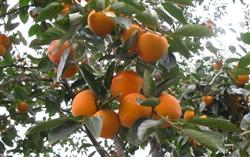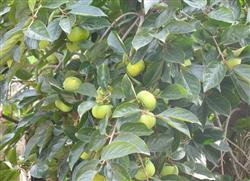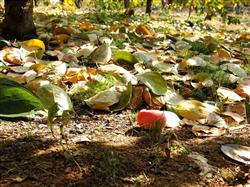How to fertilize persimmon trees?

How to fertilize persimmon trees? Persimmons are widely cultivated, easy to manage, long-lived and high-yielding fruit trees. Originated in China, Japan, Korea and other countries are also cultivated. Persimmons are deciduous trees, trees up to 10 meters above, crown width of 16 meters, life expectancy of hundreds of years. 1. Characteristics of persimmon root system vegetative growth and persimmon root system vary with rootstock. Jun Qianzi rootstock, shallow roots, fine roots, long and lasting root hair, lateral roots extend far, so barren, drought resistance. Diospyros rootstocks have deeper roots, fewer lateral roots and fine roots, and are moisture tolerant but not cold tolerant. The root system has 2~3 growth peaks in a year, and the growth peak is in rainy season, and stops in November. Persimmons like warm, strong roots, strong absorption of fertility and a wide range, so the soil requirements are not strict. But with deep soil layer, groundwater level below 1 meter, soil fertility or clay loam is appropriate. The soil pH requirements of persimmon vary with rootstock species. Diospyros yunnanensis is suitable for neutral soil and can tolerate slightly acidic or alkaline soil. Wild persimmon rootstock is suitable for slightly acidic soil. At pH50. 6.8 It is better within the scope. The total salt content of soil should not exceed 0.1% ~0.13%. The growth of persimmon trees is unfavorable when there are more CL and SO42 in soil. 2. Fertilization technology of persimmon tree (1) Fertilization period The fertilizer requirement period of persimmon tree is synchronized with the growth of new shoots, flowering, fruit and other organs. There are several key stages of fertilization in production, such as "accelerating flower fertilizer","stabilizing flower and fruit fertilizer" and "strengthening fruit fertilizer". 1. Basal fertilizer is generally applied before and after harvest (September to October) or germination (March), and it is best to apply before harvest. The basal fertilizer is mainly organic fertilizer, the application amount is 1/2 of the whole year, and attention is paid to the combined application of nitrogen, phosphorus and potassium fertilizer. The fertilizer efficiency is better when combined with watering. 2. The topdressing is mainly available nitrogen, phosphorus, potassium fertilizer and human excrement. It can be applied in several stages. Pre-flowering topdressing: late april to early may topdressing is good. Too much topdressing too early, easy to cause flower drop fruit. After flowering topdressing: persimmon after flowering, mainly available nitrogen fertilizer, followed by phosphorus fertilizer, can also be combined with spraying some trace element fertilizer. Strong fruit fertilizer: in persimmon fruit expansion and flower bud differentiation period; generally in late June to mid-July, mainly nitrogen, phosphorus and potassium appropriate. Late fruit growth: after mid-August, increase the accumulation of nutrients in the tree, early will stimulate the occurrence of autumn shoots. (2) The fertilizer amount is generally about 1000 kg, and the annual application of high-quality organic fertilizer is 300~600 kg. 3~5 year old young trees apply organic fertilizer 100 kg, plus ammonium sulfate 0.2 kg. Table 7-26 is for information only. Table 7-26 Application Amount of Three Elements of Persimmons (180 plants/ha) 1 year (kg) 5 years (kg) 10 years (kg) 15 years (kg) 20 years (kg) N 1.88 3.76 7.52 9.40 11.13 P 1.33 2.26 4.51 3.76 6.77 K 1.50 3.01 6.01 7.52 9.02 (3) Fertilization methods 1. Soil fertilization varies according to root development and extension, fertilizer and soil type. There are circular, radial and whole garden fertilization methods. 2. The time, frequency and concentration of topdressing depends on the growth cycle and tree vigor. Usually in spring shoot growth, before flowering, after flowering can spray 2~3 times. 0.3%~0.5% urea solution before flowering 0.1%~0.5% boric acid; 0.3%~0.5% urea solution after flowering 0.2%~0.3% KH_2PO_4 was sprayed 1~2 times at the peak of fruit growth in late June. During secondary fruit expansion and coloring stage, spray available nitrogen and 0.2%~0.3% phosphorus and potassium fertilizer (ammonium phosphate, potassium chloride, potassium sulfate, etc.) for 1~2 times. Click for more persimmon tree planting technology Click for more fruit planting technology
- Prev

How to manage persimmon trees in summer?
How to manage persimmon trees in summer? Please give guidance to summer persimmon management methods can refer to the following points: first, sparse fruit astringent persimmon in mid-May to early June, sweet persimmon in early June to early July, after the end of physiological fruit drop, according to the proportion of 20-25 leaves with one fruit, choose strong young fruits free of diseases and insect pests.
- Next

What is the physiological fruit drop of persimmon?
What is the physiological fruit drop of persimmon? Please introduce the causes and methods of prevention and control of physiological fruit drop of persimmon as follows: first, the factors of physiological fruit drop of persimmon. Due to improper management, persimmon will drop a lot of fruit one month after flowering. The peak of fruit drop is about 20 days after flowering, and then in August.
Related
- Moge, come on! The staff of the peasant association in the producing area of cantaloupe were frightened when the crowd gathered.
- Causes and Solutions of low Fruit setting rate of Apple
- Symptoms and control measures of passion fruit virus disease
- Fruit growing lesson: how do apple orchards keep high yields?
- Can you build orchards in the mountains? What are the pros and cons?
- How to manage the coloring period of Crisson grape?
- This paper introduces the processing technology of two kinds of fig products.
- How much is a month for retired teachers in rural areas by 2020?
- How can strawberry planting increase sugar content? We should pay attention to management in many aspects.
- What are the cultivation techniques on how to improve the yield of golden fruit?

